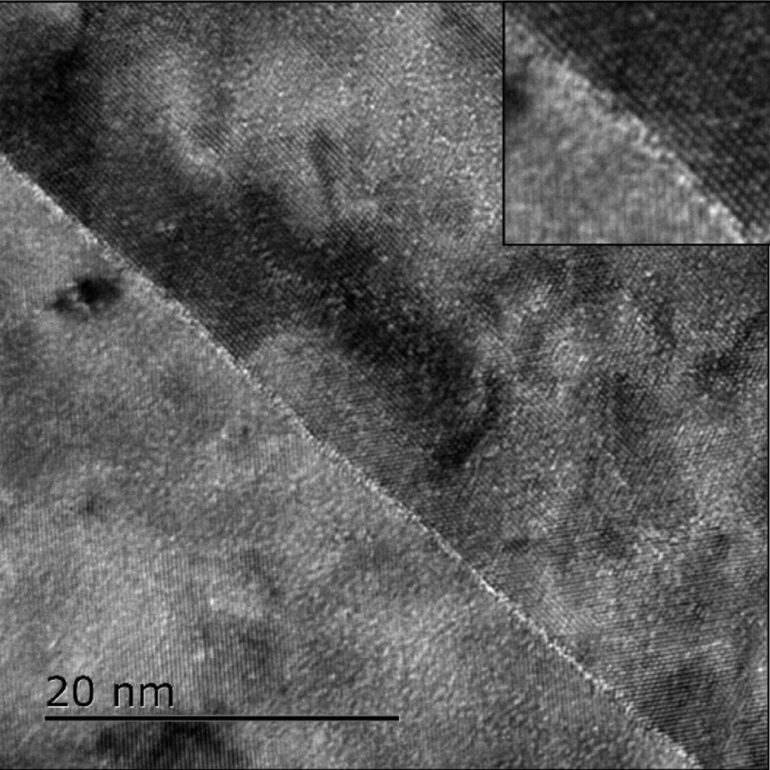In a world first, collaborative research has shown that a material that could be added to advanced fuel accumulates in certain regions, giving it desirable properties. Using the incredibly powerful microscopes at The UK’s National Nuclear Laboratory, Bangor University in Wales has helped analyze fuels manufactured by Westinghouse.
The results published in Journal of Nuclear Materials will aid decision making for future reactor technologies.
The structure of nuclear fuel
When you look at how atoms fit together, many materials have a crystalline structure. In the same way that carbon can form diamonds, metals and metal oxides can form crystals. These crystals are tiny, usually no more than a few tens of micrometers across, and fit together with random orientations. Each crystal is referred to as a grain. The size, shape, and composition, as well as how they fit together all affect the properties of a material.
Some types of nuclear fuel are made from uranium dioxide, a powder that is pressed and heated in a process, known as sintering, to form a solid pellet. Uranium dioxide has been used in nuclear reactors around the world for decades. Future, advanced reactors are likely to make some slight changes to the fuel, as a way of improving the performance of the reactor.
Dave Goddard, a fellow in fuel manufacturing and senior technical lead for the National Nuclear Laboratory, says, “Nuclear fuel has developed over decades and as analytical techniques evolve, we have new opportunities to gather more information that can lead to even greater insight.”
“One aspect of this development is to look at how the addition of chemical elements like chromium could be added to the fuel which would have many benefits. Being able to look at fuel at the atomic scale is a truly remarkable achievement which has been made possible through this collaboration between NNL, Bangor University and Westinghouse.”
Chromium oxide could be added to the fuel to improve the sintering process, leading to a denser pellet with larger grains. Since the ultimate purpose of a nuclear reactor is to produce heat which can be used for other processes such as generating low-carbon electricity, the larger grains help with heat transfer.
Tiny spaces can exist between the grains. Although they’re no more than a few atoms thick, they’re enough to affect the way that heat is transferred across the fuel pellet, and they provide space for some gases to hide in. Larger grains mean that each pellet contains fewer grains and so there will be fewer tiny spaces.
According to Prof. Simon Middleburgh from Bangor University, “Scientists have known for a while that the addition of chromium improves the sintering process and although models have suggested that this may be due to the chromium sitting at the edges of the grains, no one had looked the fuel closely enough to give a definite picture of what’s going on.”
A unique opportunity to gather new information
The National Nuclear Laboratory has a long heritage in developing nuclear fuels, and is home to a suite of powerful microscopes that are adapted to handle radioactive materials. These microscopes are made available to the wider nuclear community through the National Nuclear User Facility. Prof. Middleburgh says, “Without the support of the National Nuclear User Facility this vital research would never have been realized. The regular meetings provided the perfect opportunity to meet with experts from the National Nuclear Laboratory and form a collaboration.”
Unlike the microscopes usually seen in a lab which use visible light, these more powerful microscopes use a beam of electrons. The interaction of the electrons with the material can be used to generate a picture with resolution so fine that individual atoms can be seen.
Looking at the fuel pellets with these powerful electron microscopes, the regular ordering of the atoms in the grains could be seen. On close inspection of the grain boundaries, it was apparent that these were disordered. The grain boundaries in the chromium-containing fuel are about three atoms thick but in the pure uranium dioxide they are generally smaller. Most strikingly, there is more chromium at the grain boundary than in the rest of the grains.
Small-scale changes have a big effect on fuel performance
During the research, the fuel was produced by a commercial method that involves heating it to above 1,770°C in an atmosphere of hydrogen and carbon dioxide. Adding chromium to fuel made in this way affects the structure and chemistry of the grain boundary. Although the chromium oxide should be mixed in with the uranium dioxide it separates out during the sintering process. Seeing these disordered chromium-rich grain boundaries provides a clue to the way that larger grains form.
Dr. Adam Qaisar, senior electron microscopist at the National Nuclear Laboratory, says, “Doing exciting research is what makes us tick. Being able to see what individual atoms are doing is fascinating, and it’s made possible only by applying our expertise in nanoanalysis with multi-million-pound investments in state-of-the-art microscopes. This sort of detailed analysis expands our already vast knowledge of nuclear fuel, helping to develop advanced technologies that contribute to reaching net zero.”
These findings mean that new nuclear fuel can be finely tuned to work in a wider variety of conditions than traditional uranium dioxide does. The disordered grain boundaries should make the pellets stick to the cladding that contains them which improves the flow of heat energy to the reactor coolant, making it more efficient.
Radiation can knock atoms out of the crystalline structure, but the disordered grain boundaries are less affected and can even prevent the crystalline structure from changing. Fission of the uranium will form different chemical elements in the fuel which will also make the structure change. The chromium-rich grain boundaries, with their disordered structure, will allow the grains to slide past each other. This means that they can change shape without increasing mechanical stress in the fuel cladding. All of this means that the fuel will be incredibly robust.
Mattias Puide, fellow engineer in fuel manufacturing and processing at Westinghouse says, “We’ve known for quite a while that adding very small amounts of other elements leads to considerable benefits in fuel density, grain size and material creep at high temperatures. It has been debated whether these dopants act in the bulk of the grains or in the grain boundaries.”
“These new measurements clearly highlight that the added chromium acts in the grain boundaries. This gives us a better understanding of how the dopants work, and this knowledge will be beneficial for further development of new fuels.”
Such a small change in the fuel can greatly improve the performance of a reactor. Efficient, clean energy sources like nuclear power will be a key contribution to meeting net zero targets and helping solve the energy crisis.
More information:
Simon C. Middleburgh et al, Enrichment of Chromium at Grain Boundaries in Chromia Doped UO2, Journal of Nuclear Materials (2023). DOI: 10.1016/j.jnucmat.2023.154250
Provided by
National Nuclear Laboratory
Citation:
World’s first look at the atomic-scale of a future nuclear fuel shows how chromium can improve performance (2023, November 21)



